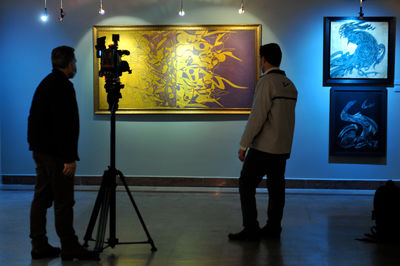Touba Zarrin is the name of the main part of the Fajr Festival of Visual Arts, which is held in a competitive manner. In the 13th Fajr Visual Arts Festival, 78 calligraphic works by 69 artists have been displayed. Among the works displayed at the Fajr Festival of Visual Arts, one can see various works that have been created in different branches of calligraphy and each has its own fans. As expected, a large number of works in this section are devoted to classical calligraphy, and Nasta'liq calligraphy is the first among the types of calligraphy. After that, there is a broken Nasta'liq of suspension and a number of works have been written with lines such as abrogation, Solss, Naskh, etc. Calligraphy works also have a colorful presence in it and you can see various effects of design and color in these works.
In the painting and gilding section of the 13th Fajr Visual Arts Festival, 78 works by 72 artists have been displayed. Shamseh is one of the common forms of gilding that has many fans and outside of its main context, the book decoration, it can have an independent presence as a decorative painting. Gol-o-Morgh (flowers and chicken) are also well-known branches of painting that are present in this festival. In paintings, we also encounter paintings that cover various subjects. The illustration section of the 13th Fajr Visual Arts Festival is ranked first in the number of works. in this section, 212 works by 99 artists are displayed.
In the field of illustration, works are produced in both custom and personal forms. These works are sometimes images based on stories and texts used for publication in books or magazines, or images provided by artists to express their personal subject or concern. In the illustration section of the Fajr Festival, there are works in both categories, among which you can see various techniques, different views, and attractive personal spaces. Also, some of the works have been displayed as the original version and some others have been printed on the chassis.
The 13th Fajr Visual Arts Festival will be held at the Saba Institute until February 20.

